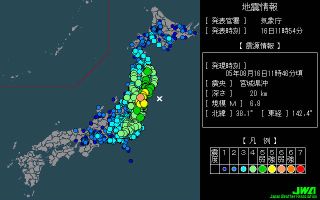
A powerful earthquake registering a preliminary magnitude of 7.2 struck northeastern Japan just before noon Tuesday, with at least 27 people reported injured in Miyagi Prefecture, and the temblor jolting extensive areas including Tokyo.
Reports of injuries include one person seriously injured and 14 others receiving slight injuries when the roof of a recently opened indoor pool in Sendai collapsed, the Sendai fire department said. There were 265 people in the pool at the time of the 11:46 a.m. earthquake. In total, at least 27 people had received treatment at hospitals in Miyagi Prefecture as of 1:30 p.m. following the quake, according to a tally compiled by Kyodo News.
The Japan Meteorological Agency initially announced the magnitude as 6.8, but revised it upward. It also warned of the possibility of an aftershock with an intensity of around upper 5 on the Japanese seismic intensity scale of 7 taking place within a month. The agency issued a tsunami warning and lifted it after waves reaching 10 centimeters high were observed on the coast of Ishinomaki, Miyagi, just after noon.
Town officials in Shizugawa in the same prefecture said a rise of 40 cm in sea level was recorded at the town's port but there were no injuries. The town has urged residents to prepare for evacuation. About 17,000 households in Miyagi and Fukushima prefectures were without electricity after the quake, Tohoku Electric Power Co. said. Operations at some nuclear power plants in Miyagi and Ibaraki prefectures, including the Onagawa nuclear power plant in Miyagi, automatically stopped when the quake struck. Several landslides have been reported in Miyagi Prefecture. Bullet train service on the Tohoku Shinkansen Line remains suspended but there were no reports of derailment or injuries. Train runs on the Yamagata and Akita Shinkansen lines are also suspended. The subway system in Sendai was temporarily shut down. The Tokaido, Joetsu and Nagano Shinkansen lines had been suspended but soon resumed. A section of the Tohoku Expressway in Miyagi Prefecture was reopened after being closed off briefly. Runways at Narita and Haneda airports, which serve the Tokyo metropolitan area, were also temporarily closed.

The strong quake prompted the central government in Tokyo, the National Police Agency and the Ground Self-Defense Force to set up respective task forces to respond to quake damage, with the GSDF and Air Self-Defense Force dispatching helicopters to evaluate the conditions.
The government dispatched a team of officials to Miyagi Prefecture to assess the damage as Prime Minister Junichiro Koizumi ordered his staff to do their best to gather information.
The quake originated in the Pacific about 80 kilometers off the coast of Miyagi Prefecture and took place at a thrust fault, the agency said. The focus was about 42 km below the surface of the sea. The Sendai weather observatory said Tuesday's temblor ''originated almost at the same spot as the 1978 (Miyagi) Earthquake but the magnitude was smaller than expected.'' It was referring to the magnitude 7.4 earthquake that struck Sendai and nearby areas in June 1978, which killed 28 and injured more than 10,000 people. Katsuyuki Abe, a professor at the University of Tokyo, said Tuesday's quake may be the big earthquake that experts have predicted would take place in the region. ''In terms of location and mechanism, this quake bears the features of the Miyagi earthquake scenario,'' Abe said.
A government panel said in January there is 99 percent likelihood a quake of magnitude 7 or above would hit the area within 30 years. Nine quakes of magnitude 6.4 or above, including the latest one, have occurred along the coast off Miyagi Prefecture since 1933. The town of Kawasaki in southern Miyagi Prefecture registered a lower 6 on the Japanese seismic intensity scale, the meteorological agency said. The quake registered 4 on the scale in central Tokyo. An intensity of lower 6 is defined as being capable of damaging wall tiles and windowpanes in many buildings and where many people find it difficult to keep standing.
No comments:
Post a Comment